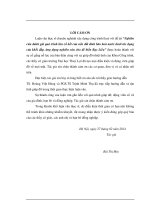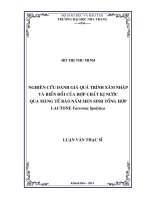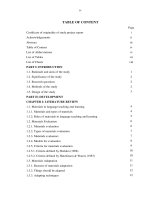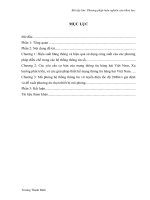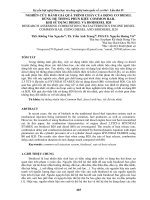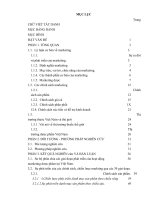Nghiên cứu đánh giá giáo trình “Family and Friends 3” dùng cho học sinh tiểu học tại Việt Nam
Bạn đang xem bản rút gọn của tài liệu. Xem và tải ngay bản đầy đủ của tài liệu tại đây (289.84 KB, 11 trang )
<span class='text_page_counter'>(1)</span><div class='page_container' data-page=1>
<b> VIETNAM NATIONAL UNIVERSITY, HANOI </b>
<b>UNIVERSITY OF LANGUAGES AND INTERNATIONAL STUDIES </b>
<b>FACULTY OF POST-GRADUATE STUDIES </b>
<b>NGUYỄN THI ̣ PHƢƠNG </b>
<b>AN EVALUATION OF THE COURSEBOOK “SOLUTIONS </b>
<b>UPPER-INTERMEDIATE” FOR TENTH-GRADE ENGLISH MAJORS AT </b>
<b>FOREIGN LANGUAGE SPECIALIZED SCHOOL, ULIS, VNU </b>
<b>(Đánh giá giáo trình “Solutions Upper-intermediate” dùng cho học sinh </b>
<b>chuyên Anh lớp 10 tại trƣờng THPT Chuyên Ngoại Ngữ, Đại học Ngoại Ngữ, </b>
<b>Đại học Quốc Gia Hà Nội) </b>
<b>M.A. MINOR PROGRAMME THESIS </b>
<b>Field: English Teaching Methodology </b>
<b>Code: 6014.0111 </b>
</div>
<span class='text_page_counter'>(2)</span><div class='page_container' data-page=2>
<b>VIETNAM NATIONAL UNIVERSITY, HANOI </b>
<b>UNIVERSITY OF LANGUAGES AND INTERNATIONAL STUDIES </b>
<b>FACULTY OF POST-GRADUATE STUDIES </b>
<b>NGUYỄN THI ̣ PHƢƠNG </b>
<b>AN EVALUATION OF THE COURSEBOOK “SOLUTIONS </b>
<b>UPPER-INTERMEDIATE” FOR TENTH-GRADE ENGLISH MAJORS AT </b>
<b>FOREIGN LANGUAGE SPECIALIZED SCHOOL, ULIS, VNU </b>
<b>(Đánh giá giáo trình “Solutions Upper-intermediate” dùng cho học sinh </b>
<b>chuyên Anh lớp 10 tại trƣờng THPT Chuyên Ngoại Ngữ, Đại học Ngoại Ngữ, </b>
<b>Đại học Quốc Gia Hà Nội) </b>
<b>M.A. MINOR PROGRAMME THESIS </b>
<b>Field: English Teaching Methodology </b>
<b>Code: 6014.0111 </b>
<b>Supervisor: Prof. Nguyễn Hòa </b>
</div>
<span class='text_page_counter'>(3)</span><div class='page_container' data-page=3>
i
<b>CANDIDATE'S STATEMENT </b>
I, Nguyen Thi Phuong, hereby certify that the thesis entitled:
<b>An evaluation of the coursebook “Solutions Upper-intermediate” for </b>
<b>tenth-grade English majors at Foreign Language Specialized School, ULIS, VNU </b>
is the results of my research for the degree of Master of Arts at University of
Languages and International Studies, Vietnam National University, Hanoi and the
thesis has not been submitted for any degrees at any other universities or tertiary
institutions.
Hanoi, 2016
</div>
<span class='text_page_counter'>(4)</span><div class='page_container' data-page=4>
ii
<b>ACKNOWLEDEGEMENT </b>
A thesis costs every researcher a lot of time to complete and mine does, too.
However, I could not finalize this study with personal efforts and without the
assistance of some enthusiastic people who I want to send my deep thanks to.
<b>The first one, I want to sincerely thank is Prof. Nguyen Hoa. He is my </b>
supervisor. His constructive comments helped me realize my mistakes and have the
reasonable corrections. In addition, his enthusiasm made each step in my research
process easier and made me feel more comfortable and be under less stress caused
by the great amount of work. Nothing can totally and exactly express my gratitude
<b>to him. I also acknowledge my gratitude to Dr. Tran Thi Tuyet for her useful </b>
lectures on materials evaluation and development. She also gives me valuable
instructions, comments, and her kindly encouragement during the development of
this thesis.
Additionally, I would like to express my appreciation to many teachers,
<b>especially Tran Thi Lan, (M.A), who is a head of English Division at FLSS and </b>
tenth-grade English majors at FLSS, ULIS, VNU for their cooperation as well as
their help in the survey. Without their support, the questionnaires and interviews
which orientate the suggestions – the heart of my thesis – could not be completed as
expected.
</div>
<span class='text_page_counter'>(5)</span><div class='page_container' data-page=5>
iii
<b>ABSTRACT </b>
The purpose of this study is to gauge the suitability of a coursebook titled
“Solutions Upper-intermediate” for students’ levels of English and general
expectations in terms of the content and language skills. Following that, the
teaching-listening situation can be identified and unsuitable content will be adapted.
Quantitative and qualitative data are obtained through questionnaires with 70
students and semi-structured interviews with 4 teachers, in which survey questions
are developed based on the students’ general expectations and MOET’s criteria.
Quantitative data in the questionnaires are calculated manually into rounded
percentages to answer two research questions. Qualitative data from “Comments” in
the questionnaires with the students and from interviewed teachers are used to
contribute more information to the answers to the research questions.
</div>
<span class='text_page_counter'>(6)</span><div class='page_container' data-page=6></div>
<span class='text_page_counter'>(7)</span><div class='page_container' data-page=7>
1
<b>CHAPTER 1: INTRODUCTION </b>
<b>1.1. Rationale </b>
In Vietnamese high schools, textbooks or coursebooks are an indispensable part in
English teaching and learning. For non-specialized high schools, they have used the
standard textbooks set by Ministry of Education and Training (MOET).
<i>Nevertheless, in addition to the use of piloted textbooks, other schools like </i>
specialized high schools have selected coursebooks for their own students. With the
current numerous number of books, the decision to choose one coursebook cannot
be taken lightly and whether it is acceptable or not is one challenging question.
Hence, teachers need to be knowledgeable enough to opt for the most suitable ones
for their students through evaluating these materials based on the guidelines and
criteria. Foreign Language Specialized School (FLSS) is a specific instance which
has chosen the coursebooks for their own students in learning English. Teachers at
English Division held a meeting and came to the conclusion that they selected
“Solutions Upper-intermediate” as the core material for tenth-grade English major
students, and this material has been used for three years. A question that plagues the
researcher is just whether this coursebook suits the students or not. Nevertheless,
there have been no strict criteria established or research on evaluating this
coursebook carried out so far.
</div>
<span class='text_page_counter'>(8)</span><div class='page_container' data-page=8>
2
<b>REFERENCES </b>
<i>1. Brown, J., D. (1988). Understanding Research in Second Language </i>
<i>Learning. A teacher’s guide to statistics and research design. Cambridge: </i>
Cambridge University Press.
<i>2. Brown, J., D. (1995). Overview of the curriculum. The Elements of language </i>
<i>curriculum: A systematic approach to program development. Boston, M.A: </i>
Heinle & Heinle.
<i>3. Brown, J., D., & Rodgers, T. S. (2005). Doing second language research. </i>
Oxford: Oxford University Press.
<i>4. Cakit, I. (2006). Evaluation of the EFL textbook “New Bridge to Success 3” </i>
<i>from the perspectives of students and teachers. Ankara, Turkey: Middle East </i>
Technical University.
<i>5. Carter, R., & Nunan, D. (2001). Teaching English to Speakers of Other </i>
<i>Languages. Cambridge: Cambridge University Press. </i>
<i>6. Cohen, L., Manion, L., & Morrison, K. (2000). Research Methods in </i>
<i>Education. London: RoutledgeFalmer. </i>
<i>7. Council of Europe (2001). Common European Framework of Reference for </i>
<i>Languages. </i> Retrieved November 19th, 2015 from
www.coe.int/t/dg4/linguistic/Source/Framework_EN.pdf
<i>8. Cunningsworth, A. (1995). Choosing Your Course Book. London: Macmillan. </i>
<i>9. Dowsett, G. (1986). Interaction in the semi-structured interview. In M.Emery </i>
(e.d.), Qualitative Research. Canberra: Australia Association of Adult
Education.
<i>10. Dudley-Evans, T., & John, M. J. S (2007). Developments in English for </i>
<i>Specific Purposes: A Multi – Disciplinary Approach. Cambridge: Cambridge </i>
University Press.
</div>
<span class='text_page_counter'>(9)</span><div class='page_container' data-page=9>
3
<i>12. Hutchinson, T. & Waters, A. (1987). English for Specific Purposes. </i>
<i>Cambridge: Cambridge University Press. </i>
<i>13. Kiely, R. & Rea-Dickins, P. (2005). Program evaluation in language </i>
<i>education. Great Britain: Palgrave Macmillan. </i>
<i>14. Le Thi Bac (2013). Evaluating the coursebook Tieng Anh 6- tap 1 (Sach </i>
<i>thi diem) compiled under the national foreign language project entitled </i>
<i>“Teaching and language foreign languages in the national education system, </i>
<i>period 2008-2020. M.A. Thesis. Hanoi: Learning Resource Center of ULIS, </i>
<i>VNU. </i>
<i>15. McDonough, J. & McDonough, S. (1997). Research Methods for English </i>
<i>Language Teachers. London: Arnold. </i>
<i>16. McDonough, J. & Shaw, C. (1993). Materials and Methods in ELT. Oxford: </i>
Blackwell.
<i>17. McGrath, I. (2002). Materials Evaluation and Design for Language </i>
<i><b>Teaching. Edinburgh: Edinburgh University Press. </b></i>
<i>18. Nunan, D. (1992). Research Methods in Language Learning. Cambridge: </i>
Cambridge University Press.
<i>19. Richards, J. C. (2001). Curriculum Development in Language Teaching. </i>
Cambridge: Cambridge University Pres.
<i>20. Sheldon, L. (1988). Evaluating ELT textbooks and materials. ELT </i>
<i>Journal, 42 (4), pp. 237-246. </i>
<i>21. Tomlinson, B. (Ed.). (1998). Materials Development in Language </i>
<i>Teaching. Cambridge: Cambridge University Press. </i>
<i>22. Tomlinson, B. (Ed.). (2003). Developing Materials for Language </i>
<i>Teaching. Cambridge: Cambridge University Press. </i>
</div>
<span class='text_page_counter'>(10)</span><div class='page_container' data-page=10>
4
<i>24. Tran Thi Chung Oanh (2010). An evaluation on the material "Lifelines" </i>
<i>for the first year non-English major students at Hai Phong University. M.A. </i>
<i>Thesis. Hanoi: Learning Resource Center of ULIS, VNU. </i>
</div>
<span class='text_page_counter'>(11)</span><div class='page_container' data-page=11></div>
<!--links-->
Tài liệu Đề tài: Nghiên cứu đánh giá quy trình chất thải rắn đô thị ở thành phố Quy Nhơn docx
- 104
- 453
- 2
